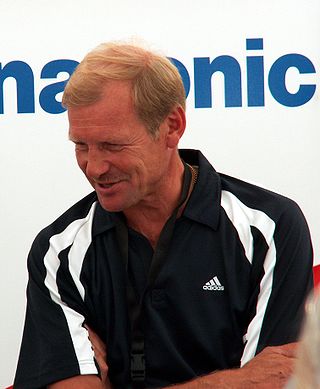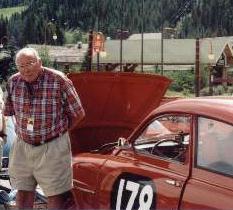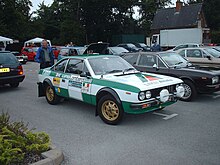
"The Flying Finn" is a nickname given to several Finnish athletes who were noted for their speed. Originally, it was given to several Finnish middle and long-distance runners. The term was later extended to notable Finnish racing drivers.

Henri Pauli Toivonen was a Finnish rally driver born in Jyväskylä, the home of Rally Finland. His father, Pauli, was the 1968 European Rally Champion for Porsche and his brother, Harri, became a professional circuit racer.

The Saab 96 is an automobile manufactured and marketed by Swedish automaker Saab from 1960 to January 1980, replacing the Saab 93. The 96 featured aerodynamic two-door bodywork, four-passenger seating and at first a two-stroke, three-cylinder engine, later a four-stroke V4.

Juha Matti Pellervo Kankkunen is a Finnish former rally driver. His factory team career in the World Rally Championship lasted from 1983 to 2002. He won 23 world rallies and four drivers' world championship titles, which were both once records in the series. Both Sébastien Loeb and Sébastien Ogier have since collected more world titles, but no driver was able to repeat Kankkunen's feat of becoming a world champion with three different manufacturers until Ogier matched this achievement in 2020.

Tommi Antero Mäkinen is a Finnish racing executive and former rally driver.

Erik Hilding Carlsson was a Swedish rally driver for Saab. He was nicknamed "Carlsson på taket" as well as Mr. Saab.

Patricia Ann Moss-Carlsson was one of the most successful female auto rally drivers of all time, achieving three outright wins and seven podium finishes in international rallies. She was crowned European Ladies' Rally Champion five times. Her older brother Stirling Moss was a Formula One Grand Prix star during the 1950s. From 1963 until her death in 2008, Swedish rally driver Erik Carlsson was both her driving-partner and her husband.

Rally Finland is a rally competition in the Finnish Lakeland in Central Finland. The rally is driven on wide and smooth gravel roads, featuring blind crests and big jumps. It is the fastest event in the World Rally Championship and has been dubbed the "Grand Prix of Rallying" and the "Grand Prix on Gravel". Rally Finland is among the largest annually organised public events in the Nordic countries, attracting hundreds of thousands of spectators each year. The rally has been known to be very difficult for non-Nordic drivers; only seven drivers from countries other than Finland or Sweden have won the event- in the 1980s and before, the field was made up almost entirely of Finnish and Swedish drivers.

The Lancia Fulvia is a car produced by Lancia between 1963 and 1976. Named after Via Fulvia, the Roman road leading from Tortona to Turin, it was introduced at the Geneva Motor Show in 1963 and manufactured in three variants: Berlina 4-door saloon, 2-door Coupé, and Sport, an alternative fastback coupé designed and built by Zagato on the Coupé floorpan.

Walter Röhrl is a German rally and auto racing driver, with victories for Fiat, Opel, Lancia and Audi as well as Porsche, Ford and BMW. Röhrl has scored 14 victories over his career, with his notable achievements including winning the World Rally Championship twice: in 1980 in a Fiat Abarth and in 1982 while driving for Opel. He has also competed in other forms of motorsport, such as endurance racing, winning in the GTP +3.0 class in the 24 Hours of Le Mans in 1981 with the Porsche System team. Röhrl also set the Pikes Peak International Hill Climb record in 1987 driving an Audi Sport Quattro S1 E2. He is often regarded as one of the greatest rally drivers of all time.

Markku Allan Alén is a Finnish former rally and race car driver. He drove for Fiat, Lancia, Subaru and Toyota in the World Rally Championship, and held the record for most stage wins (801) in the series, until Sébastien Loeb overtook it at the 2011 Rally Catalunya. Alén's phrase "now maximum attack" became well-known.

Stig Lennart Blomqvist is a retired Swedish rally driver. He made his international breakthrough in 1971. Driving an Audi Quattro for the Audi factory team, Blomqvist won the World Rally Championship drivers' title in 1984 and finished runner-up in 1985. He won his home event, the Swedish Rally, seven times.

Sandro Munari, also nicknamed 'Il Drago' is a former motor racing and rally driver from Italy.

Timo Mäkinen was a Finnish race car driver and one of the original "Flying Finns" of motor rallying. He is best remembered for his hat-trick of wins in the RAC Rally and the 1000 Lakes Rally.

Per Torsten Eklund is a Swedish Rally and Rallycross driver. His nickname is "Pekka". In rallying he never made it to the very top but he has been very successful in his later rallycross career.

Arne Hertz is a former rally co-driver from Sweden.
The 1986 World Rally Championship was the 14th season of the Fédération Internationale de l'Automobile (FIA) World Rally Championship (WRC). The season consisted of 13 rallies, including all twelve venues of the previous season as well as the addition of the Olympus Rally. This marked the return of the WRC to the United States and North America, as well as the first world rally to be held on the western side of the continent. The December rally would also be the only WRC event to feature Group B competition in the United States.

The Lancia Delta HF is a Group A rally car built for the Martini Lancia by Lancia to compete in the World Rally Championship. It is based upon the Lancia Delta road car and replaced the Lancia Delta S4. The car was introduced for the 1987 World Rally Championship season and dominated the World Rally Championship, scoring 46 WRC victories overall and winning the constructors' championship a record six times in a row from 1987 to 1992, in addition to drivers' championship titles for Juha Kankkunen and Miki Biasion, making Lancia the most successful marque in the history of the WRC and the Delta the most successful car.
The 1974 1000 Lakes Rally was the third round of the shortened 1974 World Rally Championship. It took place between 2 and 4 August 1974. The 1000 Lakes Rally didn't use special stages at this time to decide a winner. Instead all of the route was competitive - with the driver with the lowest accumulation of penalty time between time controls being declared the winner.




















